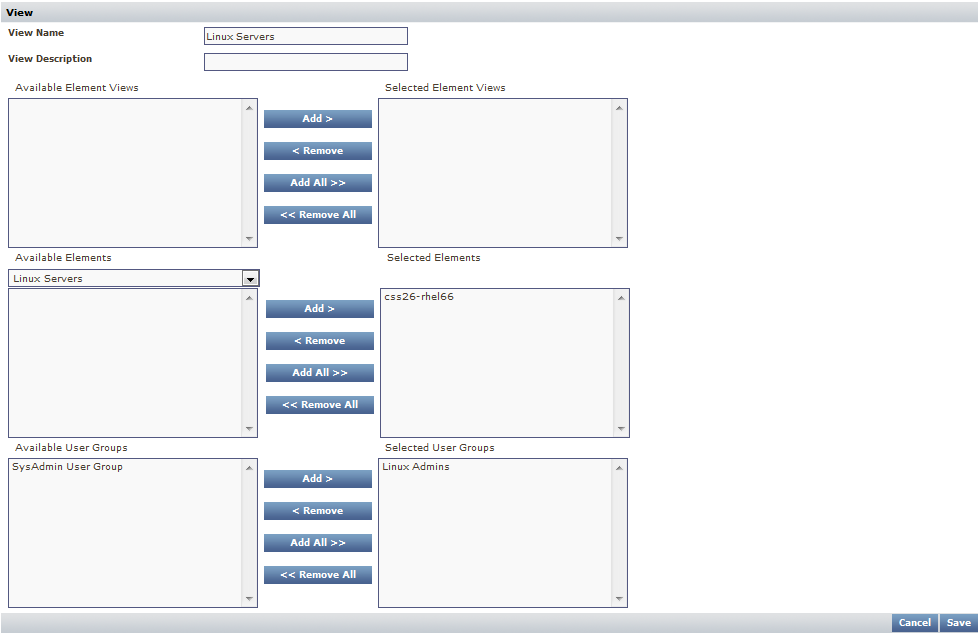...
| Exercise | Description | Time required |
|---|---|---|
| Understand Users, Groups, and Roles | Understand how up.time Uptime Infrastructure Monitor manages users and user access, by examining the two default users. | 1 slice |
| Create a New User Group | Create a user group that includes one of the existing default users, and assign it to the Web Servers Element Group you created in the previous module. | 1 slice |
| Edit an Existing User's Profile | Edit a user's User Group membership. | 1 slice |
| Create a View | Add your first View to up.timeUptime Infrastructure Monitor, and associate it with a User Group. Log in as that end user to see what that user can see when using up.timeUptime Infrastructure Monitor. | 1 slice |
Understand Users, Groups, and Roles
As mentioned previously, user management in up.time Uptime Infrastructure Monitor is the intersection of individual user profiles, user roles, and user groups. this arrangement of user-related objects is particularly useful for larger deployments, where a diverse and large set of users want to access up.time Uptime Infrastructure Monitor for different reasons. For this exercise and module, we keep the steps simple, but explain what could be done with a larger deployment.
Click the Users panel, which displays the Users page.
In this list, you can see that up.time Uptime Infrastructure Monitor has two default users (admin, or "up.time Uptime Infrastructure Monitor Administrator" and sample, or "Sample User"). Each one is assigned to its own user role (superadmin, and user), but both belong the same SysAdmin User Group:
...
To get an idea of which activities in up.time Uptime Infrastructure Monitor are determined by user role, view the permissions for the user role by clicking its name in the User Role column:
...
Let's work with this pair of default up.time Uptime Infrastructure Monitor users, and make them match completely unique personas. They already each are associated with their own role; let's put them in unique user groups.
...
Validation: View the users list again, and note that the sample user's group membership is now back to a single user group: Linux Admins. This sample user is ready to administer some Linux servers!
Create a View
- Click My Infrastructure.
- In the left pane, click Add View.
- Configure your View as follows:
- Provide
Linux Serversas the View Name. - Select the Linux Servers Element Group from the Available Elements list, displaying the Linux server Element you added in the previous module.
- Select the Element and click Add.
- From the list of Available User Groups, select and Add the Linux Admins group.
- Provide
- Click Save, then click Close Window.
Validation Step (My Infrastructure): In the main UI window, the My Infrastructure view updates with your newly created Web Servers view. Expand it to see that its contents match what you added from the Web Servers Element Group.
...
| Note | ||
|---|---|---|
| ||
Even though this created View is strictly for users that are members of the Linux Admins user group, and you are currently logged in as an administrator that is not a member, the View is still visible. An up.time Uptime Infrastructure Monitor administrator, who has the superadmin user role, is still able to view everything. |
...
- Click the logged-in admin user name (found along the top tool bar), then click Logout.
- At the log-in screen, log in as the default sample user.
This sample user has an ID and password ofsampleandsample. - Once logged in as the sample user, click My Infrastructure.
Consider the following:
- You can see the View intended solely for the sample user.
- This sample user sees this View because you configured it to be associated with the user group that the user belongs to.
- The user can also see only the same Elements under My Infrastructure because, in the second exercise in this module, you configured the user group to include the Linux Servers Element Groups.
- As explored in the first exercise, this user's role limits activity to view-only tasks. To illustrate, if you click the gear beside an Element, you do not see an Edit option in the pop-up menu.
- The user cannot see anything else on the My Infrastructure panel, because they are administrative actions.
Using Views in conjunction with user roles and user groups can accommodate a diverse set of end users that have access to view, add, edit, or delete the correct Elements or up.time Uptime Infrastructure Monitor objects.
Before moving to the next module, log in as the admin user (the ID and password were set when the Monitoring Station was first run after installation).
...
| Section | ||||||||||
|---|---|---|---|---|---|---|---|---|---|---|
| ||||||||||
|
...

